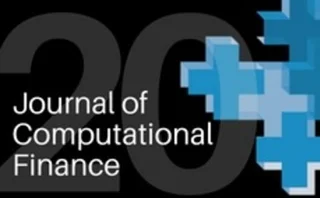Technical paper/Computational finance
Pricing American call options using the Black–Scholes equation with a nonlinear volatility function
In this paper, the authors investigate a nonlinear generalization of the Black–Scholes equation for pricing American-style call options, where the volatility term may depend on both the underlying asset price and the Gamma of the option.
Variance optimal hedging with application to electricity markets
In this paper, the author uses the mean–variance hedging criterion to value contracts in incomplete markets.
The standard market risk model of the Swiss solvency test: an analytic solution
This paper derives an alternative fast Fourier transform-based computational approach for calculating the target capital of the SST that is more than 600 times faster than a Monte Carlo simulation.
Complexity reduction for calibration to American options
In this paper, the authors propose and investigate a new method for the calibration to American option price data.
Application of the Heath–Platen estimator in the Fong–Vasicek short rate model
In this paper, the authors construct a Heath-Platen-type Monte Carlo estimator that performs extraordinarily well compared with the crude Monte Carlo estimation.
A new approach to the quantification of model risk for practitioners
This paper's aim is twofold: to introduce a mathematical framework that is sufficiently general and sound to cover the main areas of model risk, and to illustrate how a practitioner can identify the relevant abstract concepts and put them to work.
An adaptive Filon quadrature for stochastic volatility models
In this paper, the author describes a simple adaptive Filon method that performs better and more accurately than various popular alternatives for pricing options under the Heston model.
Dilated convolutional neural networks for time series forecasting
In this paper, the authors present a method for conditional time series forecasting based on an adaptation of the recent deep convolutional WaveNet architecture.
Vibrato and automatic differentiation for high-order derivatives and sensitivities of financial options
This paper deals with the computation of second-order or higher Greeks of financial securities. It combines two methods, vibrato and automatic differentiation (AD), and compares these with other methods.
Polynomial upper and lower bounds for financial derivative price functions under regime-switching
In this paper, the authors present a new approach to bounding financial derivative prices in regime-switching market models from both above and below.
Bermudan swaption model risk analysis: a local volatility approach
This paper seeks to contribute a simple and (almost) model-free way of assessing the economic value of the Bermudan exercise right derived from a “minimal” local volatility enhanced interest rate model.
Importance sampling for jump–diffusions via cross-entropy
This paper develops efficient importance sampling schemes for a class of jump–diffusion processes that are commonly used for modeling stock prices.
Importance sampling applied to Greeks for jump–diffusion models with stochastic volatility
In this paper, the authors develop a procedure to reduce the variance when numerically computing the Greeks obtained via Malliavin calculus for jump–diffusion models with stochastic volatility.
Pricing multivariate barrier reverse convertibles with factor-based subordinators
In this paper, the authors study factor-based subordinated Lévy processes in their variance gamma (VG) and normal inverse Gaussian (NIG) specifications, and focus on their ability to price multivariate exotic derivatives.
Hybrid finite-difference/pseudospectral methods for the Heston and Heston–Hull–White partial differential equations
In this paper, the authors propose a hybrid spatial finite-difference/pseudospectral discretization for European option-pricing problems under the Heston and Heston–Hull–White models.
Adjoint algorithmic differentiation tool support for typical numerical patterns in computational finance
This paper demonstrates the flexibility and ease in using C++ algorithmic differentiation (AD) tools based on overloading to numerical patterns (kernels) arising in computational finance.
Monte Carlo payoff smoothing for pricing autocallable instruments
This paper develops a Monte Carlo method to price instruments with discontinuous payoffs and non-smooth trigger functions, which allows a stable computation of Greeks via finite differences.
Model calibration with neural networks
Andres Hernandez presents a neural network approach to speed up model calibration
Smile with the Gaussian term structure model
This paper presents a natural extension of the LGM that keeps the affine structure and generates an implied volatility smile.
Numerical solution of the Hamilton–Jacobi–Bellman formulation for continuous-time mean–variance asset allocation under stochastic volatility
The paper deals with robust and accurate numerical solution methods for the nonlinear Hamilton–Jacobi–Bellman partial differential equation (PDE), which describes the dynamic optimal portfolio selection problem.
High-performance American option pricing
This paper presents a high-performance spectral collocation method for the computation of American put and call option prices.
Adjusting exponential Lévy models toward the simultaneous calibration of market prices for crash cliquets
The authors propose so-called tail thinning strategies that may be employed to better connect the calibrated models to the crash cliquets prices.
Faster comparison of stopping times by nested conditional Monte Carlo
The authors propose a novel method for efficiently comparing the performance of different stopping times.
Importance sampling for jump processes and applications to finance
Adaptive importance sampling techniques are widely known for the Gaussian setting of Brownian-driven diffusions. In this paper, the authors extend them to jump processes.


